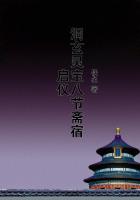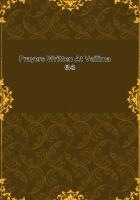And when the houses were finished, they were effective and arresting--quite different from the conventional residences of the street. They were separated by a space of twenty feet, laid out as greensward. The architect had borrowed somewhat from the Tudor school, yet not so elaborated as later became the style in many of the residences in Philadelphia and elsewhere. The most striking features were rather deep-recessed doorways under wide, low, slightly floriated arches, and three projecting windows of rich form, one on the second floor of Frank's house, two on the facade of his father's. There were six gables showing on the front of the two houses, two on Frank's and four on his father's. In the front of each house on the ground floor was a recessed window unconnected with the recessed doorways, formed by setting the inner external wall back from the outer face of the building. This window looked out through an arched opening to the street, and was protected by a dwarf parapet or balustrade. It was possible to set potted vines and flowers there, which was later done, giving a pleasant sense of greenery from the street, and to place a few chairs there, which were reached via heavily barred French casements.
On the ground floor of each house was placed a conservatory of flowers, facing each other, and in the yard, which was jointly used, a pool of white marble eight feet in diameter, with a marble Cupid upon which jets of water played. The yard which was enclosed by a high but pierced wall of green-gray brick, especially burnt for the purpose the same color as the granite of the house, and surmounted by a white marble coping which was sown to grass and had a lovely, smooth, velvety appearance. The two houses, as originally planned, were connected by a low, green-columned pergola which could be enclosed in glass in winter.
The rooms, which were now slowly being decorated and furnished in period styles were very significant in that they enlarged and strengthened Frank Cowperwood's idea of the world of art in general.
It was an enlightening and agreeable experience--one which made for artistic and intellectual growth--to hear Ellsworth explain at length the styles and types of architecture and furniture, the nature of woods and ornaments employed, the qualities and peculiarities of hangings, draperies, furniture panels, and door coverings. Ellsworth was a student of decoration as well as of architecture, and interested in the artistic taste of the American people, which he fancied would some day have a splendid outcome. He was wearied to death of the prevalent Romanesque composite combinations of country and suburban villa. The time was ripe for something new. He scarcely knew what it would be; but this that he had designed for Cowperwood and his father was at least different, as he said, while at the same time being reserved, ******, and pleasing. It was in marked contrast to the rest of the architecture of the street. Cowperwood's dining-room, reception-room, conservatory, and butler's pantry he had put on the first floor, together with the general entry-hall, staircase, and coat-room under the stairs. For the second floor he had reserved the library, general living-room, parlor, and a small office for Cowperwood, together with a boudoir for Lillian, connected with a dressing-room and bath.
On the third floor, neatly divided and accommodated with baths and dressing-rooms, were the nursery, the servants' quarters, and several guest-chambers.
Ellsworth showed Cowperwood books of designs containing furniture, hangings, etageres, cabinets, pedestals, and some exquisite piano forms. He discussed woods with him--rosewood, mahogany, walnut, English oak, bird's-eye maple, and the manufactured effects such as ormolu, marquetry, and Boule, or buhl. He explained the latter--how difficult it was to produce, how unsuitable it was in some respects for this climate, the brass and tortoise-shell inlay coming to swell with the heat or damp, and so bulging or breaking.













